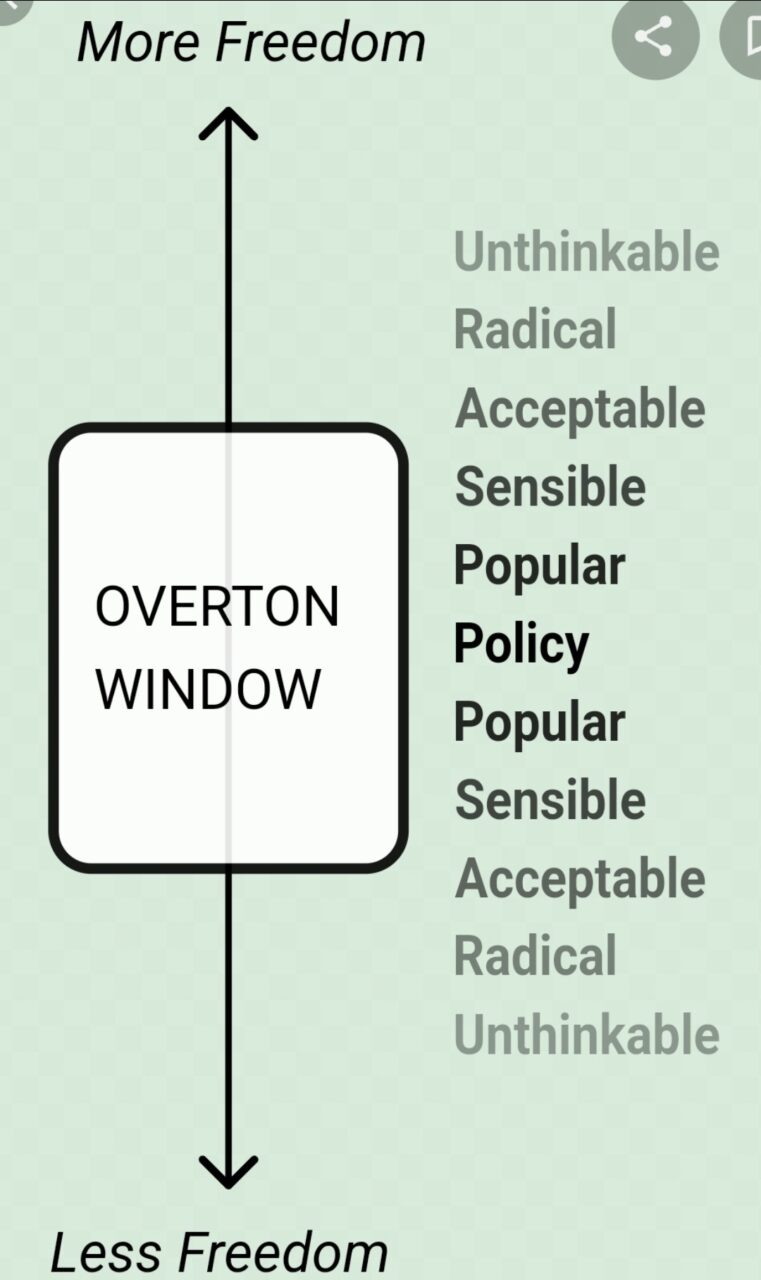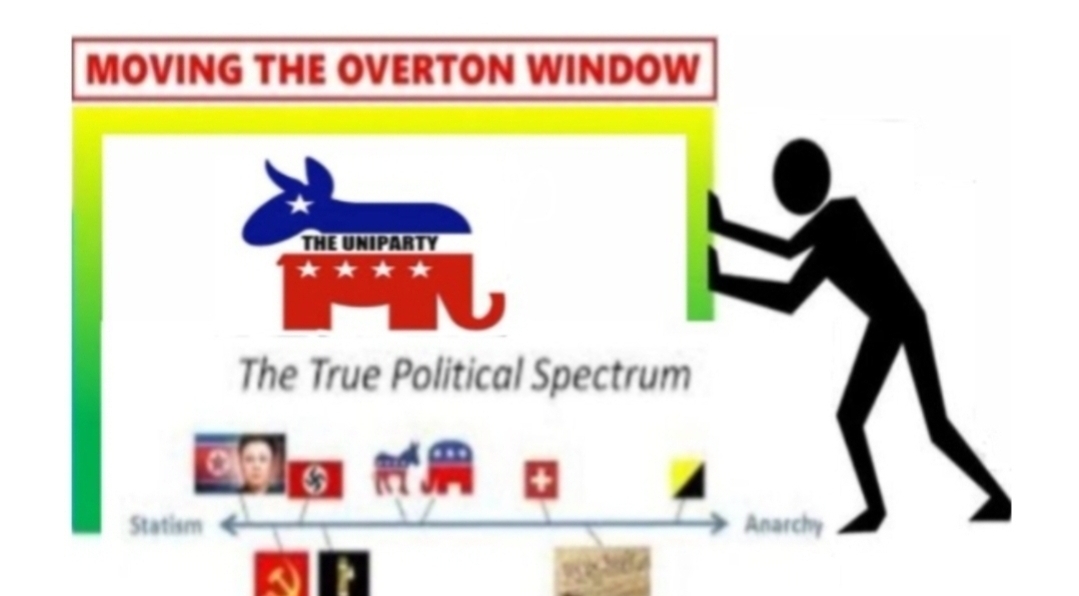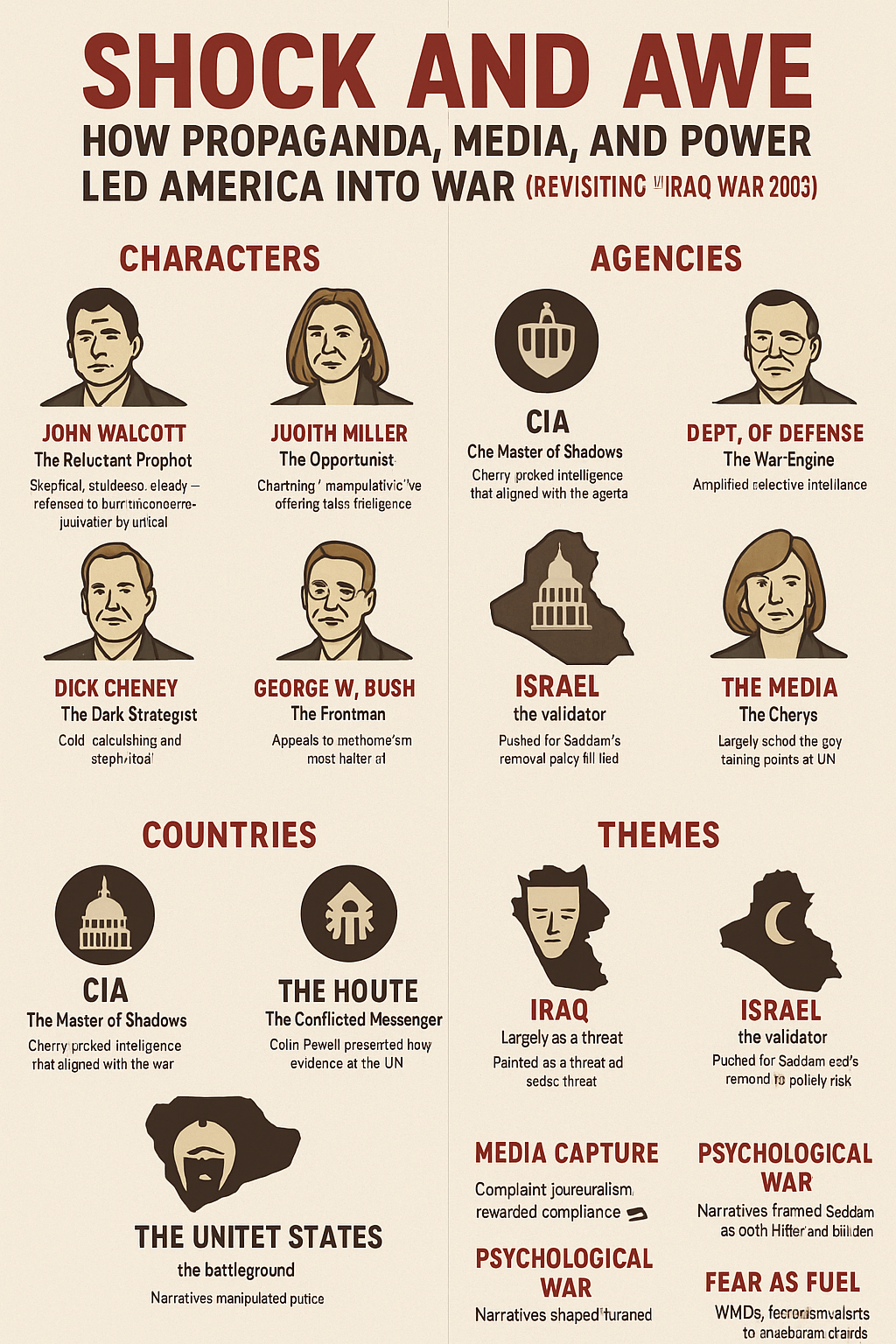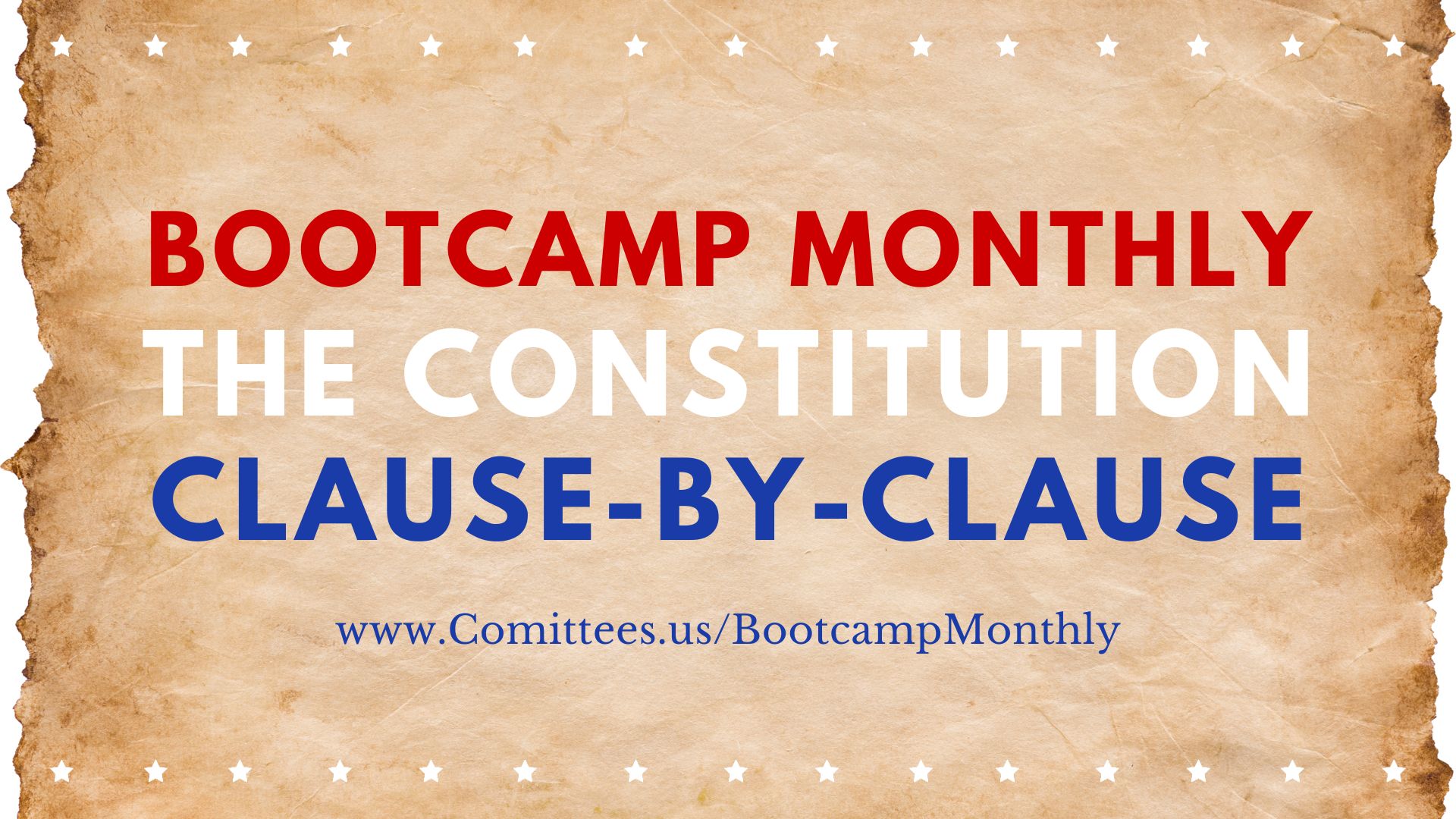Introduction: The War That Began in the Mind
The Iraq War was not only waged on the ground; it was waged in the minds of Americans. Before a single bomb fell on Baghdad, the U.S. government and its allies in the media launched a psychological campaign that overwhelmed the conscious, subconscious, and unconscious minds of millions. Fear became fuel. Lies became consensus. And dissent was drowned in a flood of patriotic fervor.
The 2017 film Shock and Awe (watch it on Amazon Prime) dramatizes this story, focusing on Knight Ridder, the last major newsroom to consistently question the Bush administration’s case for war. Yet, as the movie itself shows, their voices were mostly ignored, overshadowed by the grand spectacle of military might and the constant drumbeat of propaganda.
The Aftermath of 9/11: Fear and Narrative Seeding
The September 11th attacks created an atmosphere of fear and confusion. While the initial consensus pointed to al-Qaeda, within days Pentagon officials and neoconservative think tanks began pushing Iraq into the conversation. The Office of Special Plans, operating as a shadow intelligence unit, cherry-picked information to build a case against Saddam Hussein.
- Conscious mind: Americans were bombarded with images of burning towers, flags, and the words “terror” and “Bin Laden.”
- Subconscious mind: Iraq was slowly tied to the narrative through suggestion and speculation, creating associative links between Saddam and al-Qaeda.
- Unconscious mind: The trauma of 9/11 embedded a permanent openness to drastic government action, even without evidence.
This was the first battlefield — the battle for perception.
The Media’s Complicity and Knight Ridder’s Defiance
Most major media outlets became amplifiers for the administration. The New York Times ran Judith Miller’s now-infamous stories about aluminum tubes and mobile WMD labs, while networks repeated administration talking points uncritically.
Knight Ridder, however, stood apart. Reporters Jonathan Landay, Warren Strobel, and John Walcott repeatedly challenged the WMD narrative, citing intelligence sources who warned the evidence was thin or fabricated. Yet their stories were often buried or ignored by papers unwilling to run against the national tide.
And while Knight Ridder — a newsroom of stubborn reporters — stood as David against the Goliaths of government and monopolized media, they were ultimately drowned out. The last bastion of independent journalism was silenced not with tanks, but with mergers, buyouts, and monopolization.
Manufacturing Consent: The Overton Window in Motion
The administration’s messaging followed a familiar psychological pattern:
- Unthinkable: Iraq? Impossible.
- Radical: Iraq might have ties to terrorism.
- Acceptable: Iraq could have WMDs.
- Sensible: Iraq is a threat; preemptive war makes sense.
- Popular: Support the troops. War is patriotic.
- Policy: The invasion of Iraq begins.

Each stage wasn’t just political maneuvering — it was mental conditioning.
- Conscious mind: Slogans, press conferences, and mushroom cloud warnings captured daily thought.
- Subconscious mind: Repetition wore down resistance, making war feel inevitable.
- Unconscious mind: The trauma of 9/11 fused with nationalism, leaving Americans vulnerable to manipulation.

Shock and Awe: The War of Images
On March 19, 2003, the U.S. unleashed “Shock and Awe,” raining thousands of bombs and missiles on Baghdad. The spectacle was broadcast globally — a demonstration of overwhelming force designed to intimidate Iraq and reassure Americans of dominance.
President Bush declared victory weeks later, standing beneath a “Mission Accomplished” banner. Yet the real war — insurgency, sectarian violence, and endless occupation — had only just begun.
Why the Film Shock and Awe Fell Flat
When Rob Reiner’s Shock and Awe was released, it was met with indifference at the box office. Part of the failure was timing — by 2017, Americans were weary of war stories and numbed by years of propaganda creep. Another reason was the title itself. “Shock and Awe” sounded more like a celebration of military strategy than an indictment of lies. A title that directly exposed the Bush/Cheney administration’s dishonesty might have clarified the film’s message.
But even a different title may not have saved it. By then, apathy and indifference — the fruits of years of propaganda — had dulled the public’s appetite for revisiting uncomfortable truths.
Why It Still Matters
Since COVID-19, there has been a renewed awareness of propaganda, censorship, and the power of psychological warfare. Americans are waking up, then falling asleep again. The same patterns repeat. Fear is manufactured. Compliance becomes virtue. Dissent is stigmatized.
This is why Shock and Awe is not just a movie, but a teaching tool. It reminds us:
- That propaganda works by overwhelming all three levels of the mind.
- That courage requires questioning the narrative when everyone else is cheering.
- That silence and apathy are the greatest allies of lies.
Just as the spirit of 1776 demanded resistance to tyranny, today’s citizens must recognize the psy-war being waged for their minds. Watching Shock and Awe is not nostalgia — it is education. It is a reminder of how governments manufacture consent, how media normalizes falsehoods, and how only critical thinkers and courageous voices can hold the line.
Conclusion: A Warning, and a Call
The Iraq War was not simply a foreign policy blunder. It was the colonization of the American mind. Lies about WMDs, amplified by media, cemented into the unconsciousness of a nation. The Overton Window was shifted, permanently.
To resist future manipulations — whether about wars, pandemics, or policies — we must understand how our minds are targeted. The conscious, subconscious, and unconscious are the real battlegrounds.
And we must remember: every freedom surrendered today is one our grandchildren will never know existed.
NOTES:
The Road to Iraq: A Chronological Narrative from Shock and Awe
1. The Post-9/11 Atmosphere: Fear, Confusion, and Patriotism
- On September 11, 2001, America was struck by coordinated terrorist attacks on the World Trade Center and the Pentagon.
- The immediate framing by government and media was clear: this was al-Qaeda, led by Osama bin Laden.
- Yet, within days, key figures in the Pentagon and think tanks (Rumsfeld, Richard Perle, Bill Kristol, and the neoconservatives at Project for a New American Century) began pushing an alternative theory — that Iraq might be behind the attacks.
- This speculation, while lacking evidence, began seeding itself into the national dialogue.
2. The Pentagon’s Shadow Efforts and Manufactured Links
- Inside the Pentagon, a “special planning group” was created to bypass traditional intelligence channels like the CIA and State Department. This “Office of Special Plans” filtered information to fit a predetermined conclusion: Iraq must be linked to terrorism and weapons of mass destruction (WMDs).
- Analysts reported that intelligence was cherry-picked — decisions made first, “evidence” sought afterward.
- Former CIA Director James Woolsey was even dispatched to Europe to search for a link between Iraq and the 1993 World Trade Center bombing — an effort described as a fool’s errand.
3. The Media Begins Echoing the Message
- National networks and major newspapers (New York Times, Washington Post) began running stories tying Saddam Hussein to WMDs and terrorism. Judith Miller of the New York Times became the most infamous example, publishing stories based on Iraqi exile Ahmed Chalabi’s unverified claims.
- Meanwhile, dissenting voices — like Knight Ridder’s Warren Strobel, Jonathan Landay, and John Walcott — struggled to get their fact-checked reports published. Editors often rejected their stories, claiming they didn’t “fit” the national narrative.
- Patriotism blurred into nationalism; dissent was framed as unpatriotic.
4. The Congressional Debate and Authorization
- By late 2002, the Bush administration ramped up its public case. Vice President Cheney declared Saddam was “on the threshold of developing a nuclear weapon.” Condoleezza Rice warned, “We don’t want the smoking gun to be a mushroom cloud.”
- Colin Powell, under pressure, presented “evidence” at the United Nations in February 2003 — aluminum tubes, mobile labs, and defectors’ claims. Most of this was later discredited, but at the time it provided the cover needed.
- Congress, under bipartisan pressure, voted to authorize the use of force in Iraq. Senators Biden, Clinton, Kerry, McCain, and others supported it, despite warnings from a handful recalling the Gulf of Tonkin deception in Vietnam.
5. The Propaganda Machine in Full Swing
- In the months leading up to invasion, television was flooded with images of troops, missiles, and the phrase “Shock and Awe.”
- The Bush administration claimed regime change would be swift, that Iraqis would greet U.S. forces as liberators, and that the war would last “six days, six weeks, I doubt six months.”
- They also reassured taxpayers it wouldn’t cost Americans much: Iraq’s oil revenue, they said, would pay for reconstruction.
6. The War Begins: Shock and Awe
- On March 19, 2003, the U.S. launched a massive bombardment of Baghdad: 3,000 cruise missiles, precision bombs, and relentless firepower — a display designed to intimidate the enemy and dazzle the American public.
- President Bush framed it as necessary “to disarm Iraq, free its people, and defend the world from grave danger.”
- Within weeks, Baghdad fell. On May 1, 2003, Bush gave his infamous “Mission Accomplished” speech aboard an aircraft carrier, declaring major combat operations over.
7. The Aftermath — Lies and Costs Revealed
- No WMDs were found.
- Iraq descended into chaos, sectarian conflict, and civil war.
- Thousands of U.S. troops and hundreds of thousands of Iraqi civilians were killed.
- The war, promised to be quick and cheap, lasted nearly a decade and cost trillions.
- Knight Ridder, largely ignored during the lead-up, was later vindicated for its reporting. Yet by then, mergers and monopolization had already begun silencing independent outlets.







